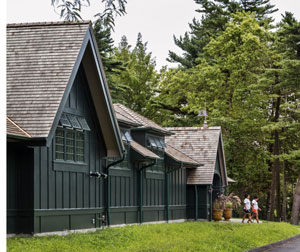Fellows Focus: Douglas Wright
 We are always eager to learn more from the new Fellows joining our group! Douglas Wright, who joined the Fellows last year, has much to share. As founder of Douglas C. Wright Architects in New York, Douglas has a keen eye for design that honors the landscape. Douglas recently spoke with us about his personal passion for architecture and gardens, and shared some tips on how good design can heighten the connection between interior and exterior spaces.
We are always eager to learn more from the new Fellows joining our group! Douglas Wright, who joined the Fellows last year, has much to share. As founder of Douglas C. Wright Architects in New York, Douglas has a keen eye for design that honors the landscape. Douglas recently spoke with us about his personal passion for architecture and gardens, and shared some tips on how good design can heighten the connection between interior and exterior spaces.
When did your interest in architecture and design begin?
I was hooked on design from the time I was a very young child. I grew up in an old house next to a ravine with a gentle stream and all sorts of native northeastern plants. I learned engineering and materials building dams, forts, castles, etc. Working with nature was the best training possible. Of course, I had the very good fortune to land in a few architecture classes at Yale and discover that there was a very positive way to focus all those interests.
For the past eight years, your firm has worked on all types of projects, including private residences, institutions, and historic properties. What types of projects most inspire you?
You learn so much from each one; they’re all distinct and each building type feeds creativity. A country club is like a big house, and the best clubs have intimate touches like a home. Working on historic properties has taught me great admiration for how my forebears solved design or engineering problems with the tools they had at hand. With houses and institutions, I love getting to know my clients and what they want the place to be. The best architecture reflects the client as much as the architect; it should manifest the message of the client, whatever that may be. And I’ve enjoyed working for institutions and clients with a broad range of interests, hopes, and beautiful and inspiring messages.
 When working on a project with property, how does the landscape influence your overall design decisions?
When working on a project with property, how does the landscape influence your overall design decisions?
No matter the form of architecture – a home or a palace or a temple– its most powerful quality is its rootedness in the place. I always loved hearing [Yale art historian]Vincent Scully speak about the siting of Greek or Minoan temples and their relation to the surrounding hills, mountains, and the sea. Those are very big aspects of place that I always carry into the design of a project. A project with property affords the very exciting opportunity of knowing this outer landscape, appreciating the attributes of the site, and then shaping the gardens and architecture together to create a very personal place in the larger setting. The landscape influences my design decisions because I’m always trying to create connections between the architecture and the landscape.
You recently joined the Garden Conservancy as a Fellow, welcome! What brought you to join this group of like-minded garden enthusiasts?
My love for gardens has been constant and my good friend Joe Marek, undergraduate classmate, finally asked me why I wasn’t a member. As he spoke more about the group, I quickly found myself without a good answer! Fellows Doug Hoerr and Janice Parker are good friends as well, so that was further motivation. The Fellows’ tours open so many private, beautifully designed gardens, and the care and sharing exhibited in all is extraordinary. Just to get a glimpse of these gardens is inspiring. Spending some extended time to think, observe, and learn are the moments I look forward to.
 What advice would you give a Fellow looking to cohesively redesign both their indoor and outdoor spaces? Any tips or best practices to follow?
What advice would you give a Fellow looking to cohesively redesign both their indoor and outdoor spaces? Any tips or best practices to follow?
Certainly! Just keeping it very practical, I always start about a half mile away from the place I’m going to design, then walk towards it and place a marker at each point where I’m aware of a threshold or a change in awareness of the site, landscape, or interior. It can be very basic, like the turn off the road onto a property, and it can be more complex, like a gentle rise that affords a view, or a gate within a garden (or where you think one might be nice). In this way, I start marking off important points both inside and out where I want to make connections or think about a feeling or reaction that’s already in the place. Good design heightens these feelings (or creates new ones!)
 Do you have a garden at your residence? If so, tell us a little bit about it; what features do you most enjoy?
Do you have a garden at your residence? If so, tell us a little bit about it; what features do you most enjoy?
I live in a classic, traditional farm house from the 1920s by architect Clifford Wendehack, who designed many of the country clubs in the Northeast, including Winged Foot Golf Club and the Short Hills Club. Like so many houses from that era, the best rooms afford views to the garden through windows on three walls. From the inside, these views have guided my shaping of spaces within the garden (I love ovals and bounded areas), my placement of plants, and connections between spaces. I love experimenting with different plants and architectural ideas, and I’ve used the larger spaces to bring some organization to a lot of objects and furniture in the gardens. It’s inspiring to see how different designers have knit together different ideas in the gardens I’ve toured since becoming a Fellow. I have a ways to go in this regard: I love small and large sculptures and have decorated the garden with them, but then I also have walls with trellises for grapes and clematis. My daughter is convinced we’ll be making wine soon.
Any other thoughts or remarks you’d like to share with our Fellows community?
I look forward to meeting you in the gardens!
To learn more about Douglas and his work at Douglas C. Wright Architects, visit www.dcwarchitects.com.
Photos (top to bottom): Tool shed, Buzzards Bay, MA, photo by David Sundberg; Cornwall, CT, photo by Costas Picadas; Pool complex entry, Winged Foot Golf Club, NY, photo by Richard Powers
